Astrophysical Plasma Processes: Analysis of Solar Phenomena
VerifiedAdded on 2023/01/17
|14
|1978
|82
Homework Assignment
AI Summary
This assignment delves into the realm of astrophysical plasma processes, encompassing both theoretical concepts and practical calculations. The first part focuses on calculations related to the solar wind, including the application of Parker's equation and the determination of plasma parameters for ...

0
ASTROPHYSICAL PLASMA PROCESSES
ASTROPHYSICAL PLASMA PROCESSES.
Name of Student
Institution Affiliation
ASTROPHYSICAL PLASMA PROCESSES
ASTROPHYSICAL PLASMA PROCESSES.
Name of Student
Institution Affiliation
Paraphrase This Document
Need a fresh take? Get an instant paraphrase of this document with our AI Paraphraser
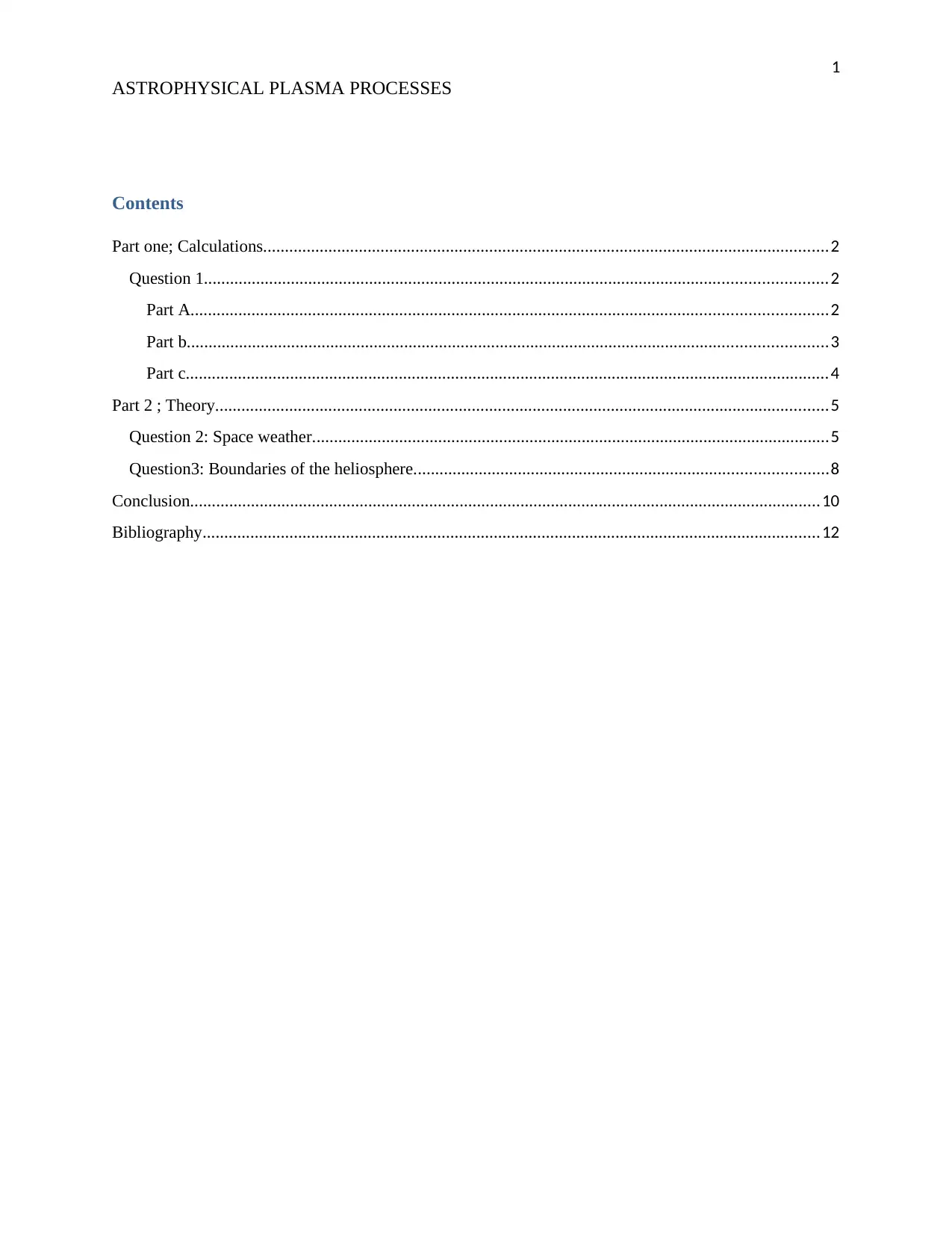
1
ASTROPHYSICAL PLASMA PROCESSES
Contents
Part one; Calculations..................................................................................................................................2
Question 1...............................................................................................................................................2
Part A..................................................................................................................................................2
Part b...................................................................................................................................................3
Part c....................................................................................................................................................4
Part 2 ; Theory.............................................................................................................................................5
Question 2: Space weather.......................................................................................................................5
Question3: Boundaries of the heliosphere...............................................................................................8
Conclusion.................................................................................................................................................10
Bibliography..............................................................................................................................................12
ASTROPHYSICAL PLASMA PROCESSES
Contents
Part one; Calculations..................................................................................................................................2
Question 1...............................................................................................................................................2
Part A..................................................................................................................................................2
Part b...................................................................................................................................................3
Part c....................................................................................................................................................4
Part 2 ; Theory.............................................................................................................................................5
Question 2: Space weather.......................................................................................................................5
Question3: Boundaries of the heliosphere...............................................................................................8
Conclusion.................................................................................................................................................10
Bibliography..............................................................................................................................................12

2
ASTROPHYSICAL PLASMA PROCESSES
Part one; Calculations.
Question 1
Part A.
a) Parker proposed a steady flowing solar wind he could explain both the orientation
of the cometary plasma tail. According to his argument integration of the mass
conservation equation gets finds Vr2 = C where C is a constant
I =4 pr 2 rV
Where I is the mass flux through a sun centered sphere of radius r, which is constant when the
flow is independent of time.
Again assuming an isothermal expansion for p the momentum equation becomes
ρV dv /dr=−2 KbT dn /dr−ρGM /r2
Dividing by _ nm gives V
V dv
dr =−2 KbT
m
1
n − GM
r 2
Our aim is to reduce this to an equation for V(r), so from the mass conservation equation.
n= 1
4 πm
1
Vr 2
Differentiating
ASTROPHYSICAL PLASMA PROCESSES
Part one; Calculations.
Question 1
Part A.
a) Parker proposed a steady flowing solar wind he could explain both the orientation
of the cometary plasma tail. According to his argument integration of the mass
conservation equation gets finds Vr2 = C where C is a constant
I =4 pr 2 rV
Where I is the mass flux through a sun centered sphere of radius r, which is constant when the
flow is independent of time.
Again assuming an isothermal expansion for p the momentum equation becomes
ρV dv /dr=−2 KbT dn /dr−ρGM /r2
Dividing by _ nm gives V
V dv
dr =−2 KbT
m
1
n − GM
r 2
Our aim is to reduce this to an equation for V(r), so from the mass conservation equation.
n= 1
4 πm
1
Vr 2
Differentiating
⊘ This is a preview!⊘
Do you want full access?
Subscribe today to unlock all pages.

Trusted by 1+ million students worldwide
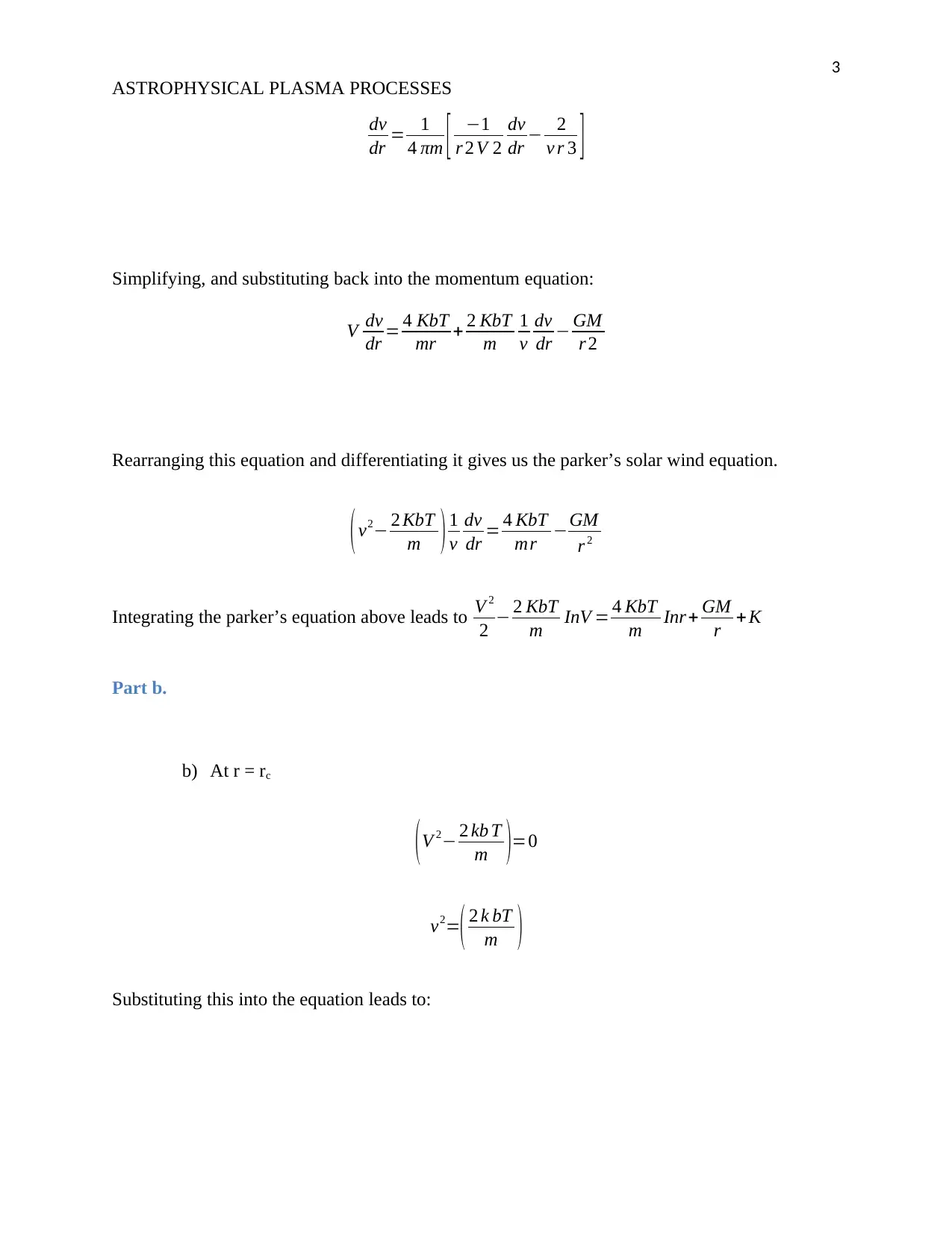
3
ASTROPHYSICAL PLASMA PROCESSES
dv
dr = 1
4 πm [ −1
r 2 V 2
dv
dr − 2
v r 3 ]
Simplifying, and substituting back into the momentum equation:
V dv
dr = 4 KbT
mr + 2 KbT
m
1
v
dv
dr − GM
r 2
Rearranging this equation and differentiating it gives us the parker’s solar wind equation.
(v2− 2 KbT
m ) 1
v
dv
dr = 4 KbT
mr −GM
r 2
Integrating the parker’s equation above leads to V 2
2 − 2 KbT
m InV = 4 KbT
m Inr+ GM
r + K
Part b.
b) At r = rc
(V 2− 2 kb T
m )=0
v2=( 2 k bT
m )
Substituting this into the equation leads to:
ASTROPHYSICAL PLASMA PROCESSES
dv
dr = 1
4 πm [ −1
r 2 V 2
dv
dr − 2
v r 3 ]
Simplifying, and substituting back into the momentum equation:
V dv
dr = 4 KbT
mr + 2 KbT
m
1
v
dv
dr − GM
r 2
Rearranging this equation and differentiating it gives us the parker’s solar wind equation.
(v2− 2 KbT
m ) 1
v
dv
dr = 4 KbT
mr −GM
r 2
Integrating the parker’s equation above leads to V 2
2 − 2 KbT
m InV = 4 KbT
m Inr+ GM
r + K
Part b.
b) At r = rc
(V 2− 2 kb T
m )=0
v2=( 2 k bT
m )
Substituting this into the equation leads to:
Paraphrase This Document
Need a fresh take? Get an instant paraphrase of this document with our AI Paraphraser

4
ASTROPHYSICAL PLASMA PROCESSES
2 kbT
2 m − 2 kbT
m InV = 4 kbT
m Inr + GM
r +K
Making K the subject of the formula leads us to 2 kbT
2 m − 2 kbT
m InV − 4 kbT
m Inr− GM
r
Thus the value of K= 2 kbT
2 m − 2 kbT
m ∈ √ 2 kbT
m − 4 kbT
m Inr −GM
r
Part c.
c) For mercury
Proton density= 0.39 AU ×6.6 cm3
1 AU =2.574cm-3
Magnetic field strength 0.37 AU ×7 nT
1 AU = 7.73nT
Spiral angle 0.39 × 45°=17.550
For mars:
Proton density: = 1.5 AU ×6.6 cm3
1 AU = 9.9cm-3
Magnetic field strength 1.5 AU ×7 nT
1 AU = 10.5nT
Spiral angle 1.5 × 45°=67.50
For Jupiter
ASTROPHYSICAL PLASMA PROCESSES
2 kbT
2 m − 2 kbT
m InV = 4 kbT
m Inr + GM
r +K
Making K the subject of the formula leads us to 2 kbT
2 m − 2 kbT
m InV − 4 kbT
m Inr− GM
r
Thus the value of K= 2 kbT
2 m − 2 kbT
m ∈ √ 2 kbT
m − 4 kbT
m Inr −GM
r
Part c.
c) For mercury
Proton density= 0.39 AU ×6.6 cm3
1 AU =2.574cm-3
Magnetic field strength 0.37 AU ×7 nT
1 AU = 7.73nT
Spiral angle 0.39 × 45°=17.550
For mars:
Proton density: = 1.5 AU ×6.6 cm3
1 AU = 9.9cm-3
Magnetic field strength 1.5 AU ×7 nT
1 AU = 10.5nT
Spiral angle 1.5 × 45°=67.50
For Jupiter

5
ASTROPHYSICAL PLASMA PROCESSES
Proton density = 5.2 AU × 6.6 cm3
1 AU = 34.32cm-3
Magnetic field strength = 5.2 AU × 7
1 = 36.4nT
Spiral angle = 5.2 AU × 45°= 2340
For Neptune
Proton density; = 30 AU ×6.6 cm3
1 AU = 198cm-3
Magnetic field strength 30 AU ×7 nT
1 AU = 210nT
Spiral angle = 30 AU × 45°= 13500
Part 2 ; Theory.
Question 2: Space weather.
The term space weather usually states the conditions on the sun, in the solar wind, and within
Earth's magnetosphere, ionosphere and thermosphere that can affect the performance and
ASTROPHYSICAL PLASMA PROCESSES
Proton density = 5.2 AU × 6.6 cm3
1 AU = 34.32cm-3
Magnetic field strength = 5.2 AU × 7
1 = 36.4nT
Spiral angle = 5.2 AU × 45°= 2340
For Neptune
Proton density; = 30 AU ×6.6 cm3
1 AU = 198cm-3
Magnetic field strength 30 AU ×7 nT
1 AU = 210nT
Spiral angle = 30 AU × 45°= 13500
Part 2 ; Theory.
Question 2: Space weather.
The term space weather usually states the conditions on the sun, in the solar wind, and within
Earth's magnetosphere, ionosphere and thermosphere that can affect the performance and
⊘ This is a preview!⊘
Do you want full access?
Subscribe today to unlock all pages.

Trusted by 1+ million students worldwide
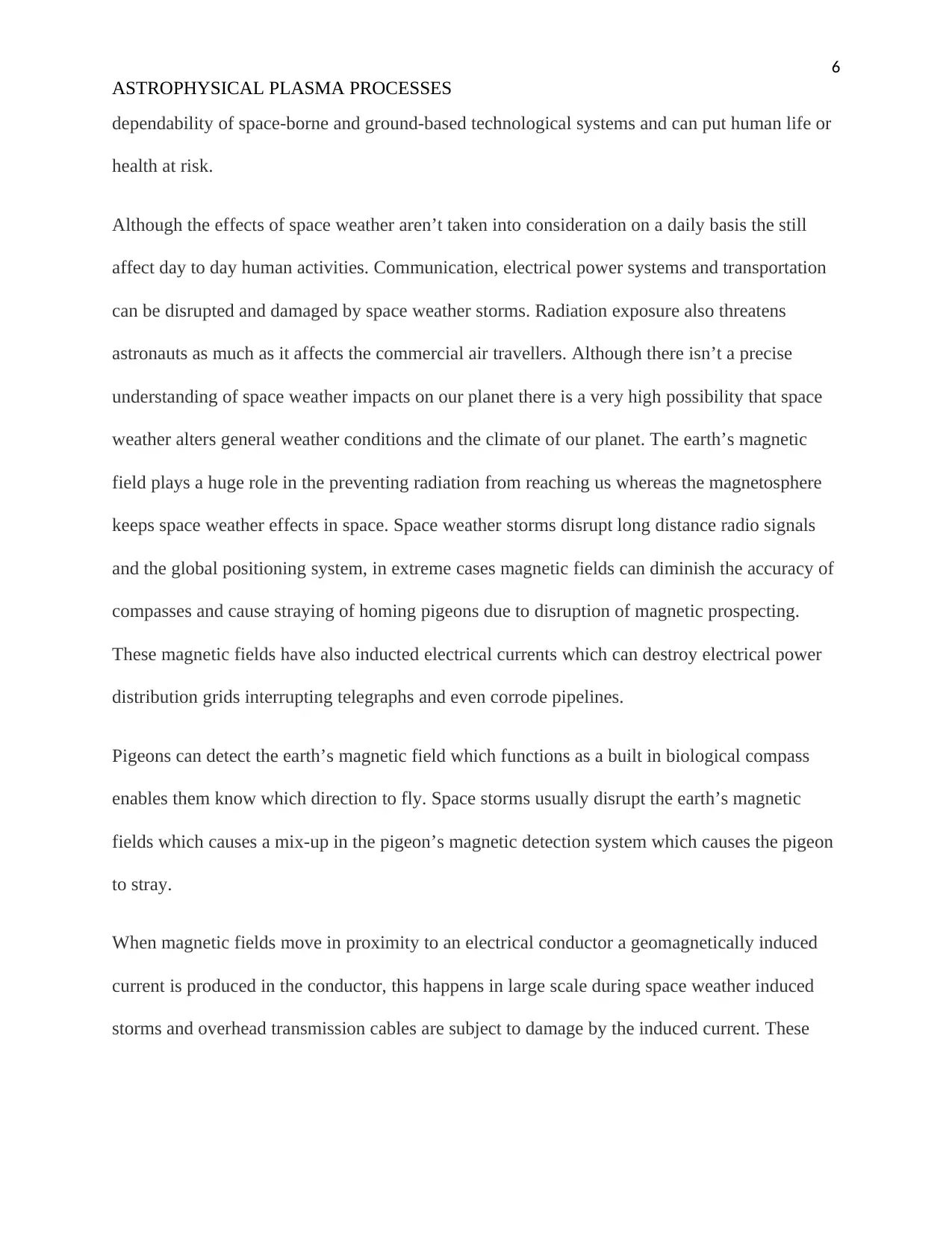
6
ASTROPHYSICAL PLASMA PROCESSES
dependability of space-borne and ground-based technological systems and can put human life or
health at risk.
Although the effects of space weather aren’t taken into consideration on a daily basis the still
affect day to day human activities. Communication, electrical power systems and transportation
can be disrupted and damaged by space weather storms. Radiation exposure also threatens
astronauts as much as it affects the commercial air travellers. Although there isn’t a precise
understanding of space weather impacts on our planet there is a very high possibility that space
weather alters general weather conditions and the climate of our planet. The earth’s magnetic
field plays a huge role in the preventing radiation from reaching us whereas the magnetosphere
keeps space weather effects in space. Space weather storms disrupt long distance radio signals
and the global positioning system, in extreme cases magnetic fields can diminish the accuracy of
compasses and cause straying of homing pigeons due to disruption of magnetic prospecting.
These magnetic fields have also inducted electrical currents which can destroy electrical power
distribution grids interrupting telegraphs and even corrode pipelines.
Pigeons can detect the earth’s magnetic field which functions as a built in biological compass
enables them know which direction to fly. Space storms usually disrupt the earth’s magnetic
fields which causes a mix-up in the pigeon’s magnetic detection system which causes the pigeon
to stray.
When magnetic fields move in proximity to an electrical conductor a geomagnetically induced
current is produced in the conductor, this happens in large scale during space weather induced
storms and overhead transmission cables are subject to damage by the induced current. These
ASTROPHYSICAL PLASMA PROCESSES
dependability of space-borne and ground-based technological systems and can put human life or
health at risk.
Although the effects of space weather aren’t taken into consideration on a daily basis the still
affect day to day human activities. Communication, electrical power systems and transportation
can be disrupted and damaged by space weather storms. Radiation exposure also threatens
astronauts as much as it affects the commercial air travellers. Although there isn’t a precise
understanding of space weather impacts on our planet there is a very high possibility that space
weather alters general weather conditions and the climate of our planet. The earth’s magnetic
field plays a huge role in the preventing radiation from reaching us whereas the magnetosphere
keeps space weather effects in space. Space weather storms disrupt long distance radio signals
and the global positioning system, in extreme cases magnetic fields can diminish the accuracy of
compasses and cause straying of homing pigeons due to disruption of magnetic prospecting.
These magnetic fields have also inducted electrical currents which can destroy electrical power
distribution grids interrupting telegraphs and even corrode pipelines.
Pigeons can detect the earth’s magnetic field which functions as a built in biological compass
enables them know which direction to fly. Space storms usually disrupt the earth’s magnetic
fields which causes a mix-up in the pigeon’s magnetic detection system which causes the pigeon
to stray.
When magnetic fields move in proximity to an electrical conductor a geomagnetically induced
current is produced in the conductor, this happens in large scale during space weather induced
storms and overhead transmission cables are subject to damage by the induced current. These
Paraphrase This Document
Need a fresh take? Get an instant paraphrase of this document with our AI Paraphraser
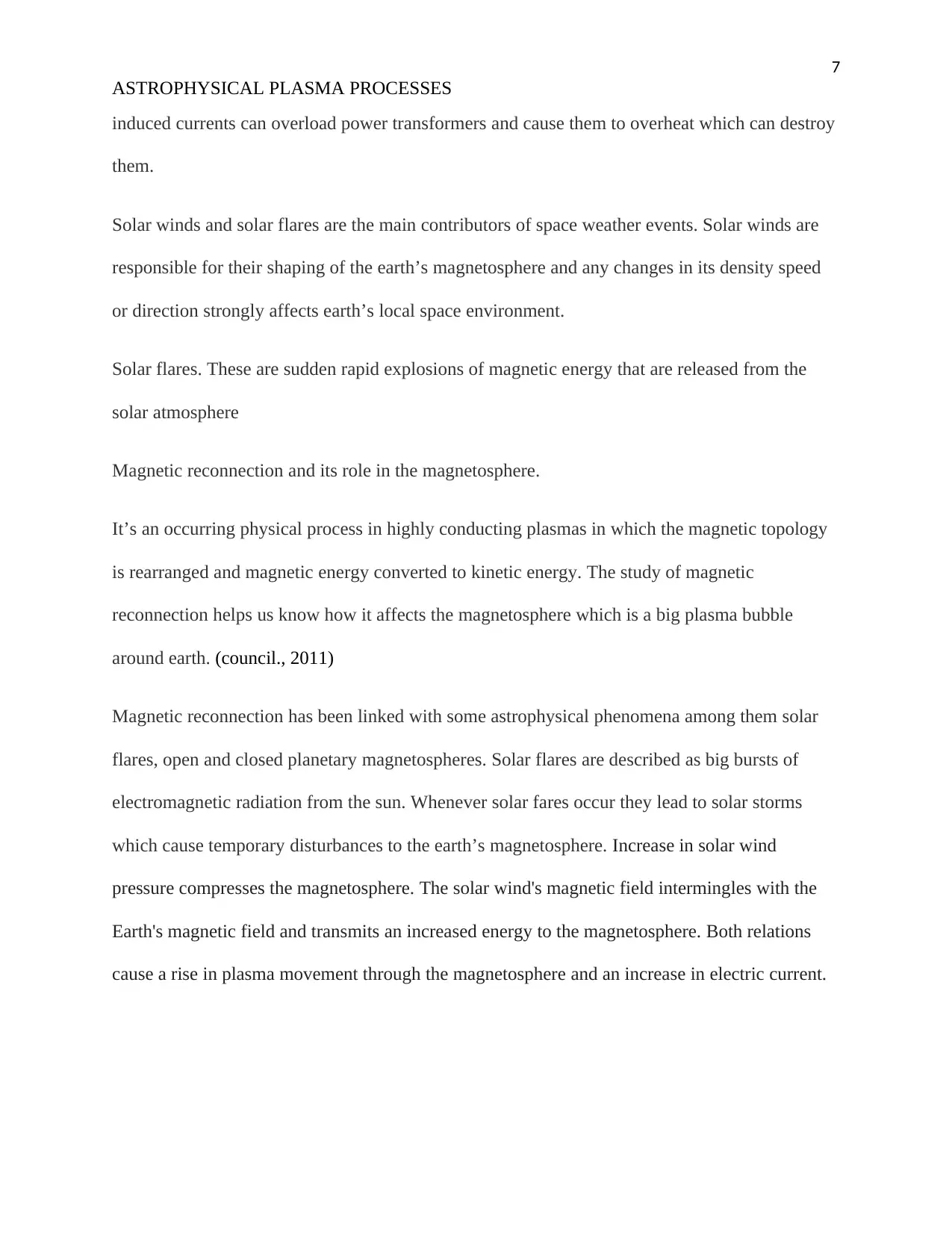
7
ASTROPHYSICAL PLASMA PROCESSES
induced currents can overload power transformers and cause them to overheat which can destroy
them.
Solar winds and solar flares are the main contributors of space weather events. Solar winds are
responsible for their shaping of the earth’s magnetosphere and any changes in its density speed
or direction strongly affects earth’s local space environment.
Solar flares. These are sudden rapid explosions of magnetic energy that are released from the
solar atmosphere
Magnetic reconnection and its role in the magnetosphere.
It’s an occurring physical process in highly conducting plasmas in which the magnetic topology
is rearranged and magnetic energy converted to kinetic energy. The study of magnetic
reconnection helps us know how it affects the magnetosphere which is a big plasma bubble
around earth. (council., 2011)
Magnetic reconnection has been linked with some astrophysical phenomena among them solar
flares, open and closed planetary magnetospheres. Solar flares are described as big bursts of
electromagnetic radiation from the sun. Whenever solar fares occur they lead to solar storms
which cause temporary disturbances to the earth’s magnetosphere. Increase in solar wind
pressure compresses the magnetosphere. The solar wind's magnetic field intermingles with the
Earth's magnetic field and transmits an increased energy to the magnetosphere. Both relations
cause a rise in plasma movement through the magnetosphere and an increase in electric current.
ASTROPHYSICAL PLASMA PROCESSES
induced currents can overload power transformers and cause them to overheat which can destroy
them.
Solar winds and solar flares are the main contributors of space weather events. Solar winds are
responsible for their shaping of the earth’s magnetosphere and any changes in its density speed
or direction strongly affects earth’s local space environment.
Solar flares. These are sudden rapid explosions of magnetic energy that are released from the
solar atmosphere
Magnetic reconnection and its role in the magnetosphere.
It’s an occurring physical process in highly conducting plasmas in which the magnetic topology
is rearranged and magnetic energy converted to kinetic energy. The study of magnetic
reconnection helps us know how it affects the magnetosphere which is a big plasma bubble
around earth. (council., 2011)
Magnetic reconnection has been linked with some astrophysical phenomena among them solar
flares, open and closed planetary magnetospheres. Solar flares are described as big bursts of
electromagnetic radiation from the sun. Whenever solar fares occur they lead to solar storms
which cause temporary disturbances to the earth’s magnetosphere. Increase in solar wind
pressure compresses the magnetosphere. The solar wind's magnetic field intermingles with the
Earth's magnetic field and transmits an increased energy to the magnetosphere. Both relations
cause a rise in plasma movement through the magnetosphere and an increase in electric current.
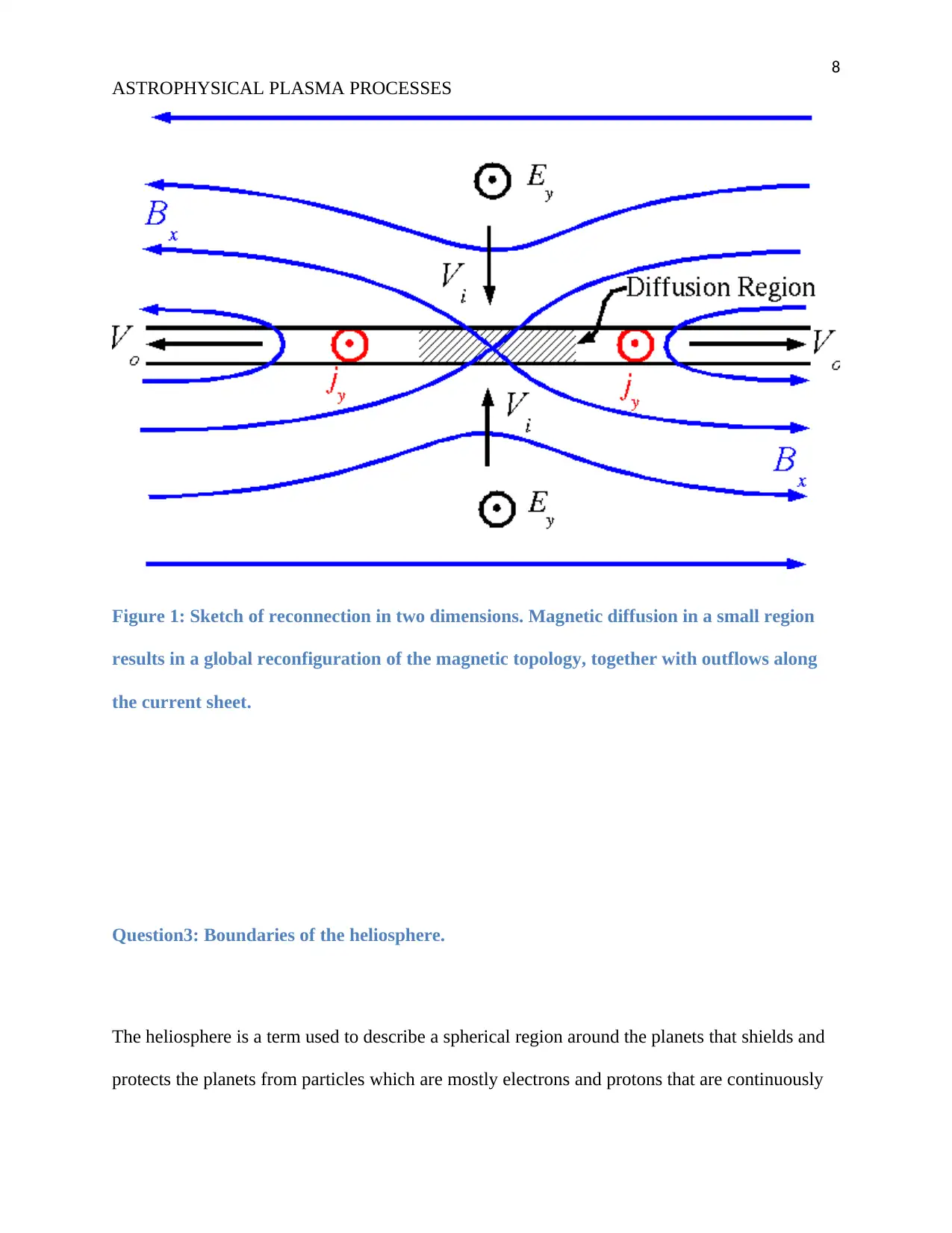
8
ASTROPHYSICAL PLASMA PROCESSES
Figure 1: Sketch of reconnection in two dimensions. Magnetic diffusion in a small region
results in a global reconfiguration of the magnetic topology, together with outflows along
the current sheet.
Question3: Boundaries of the heliosphere.
The heliosphere is a term used to describe a spherical region around the planets that shields and
protects the planets from particles which are mostly electrons and protons that are continuously
ASTROPHYSICAL PLASMA PROCESSES
Figure 1: Sketch of reconnection in two dimensions. Magnetic diffusion in a small region
results in a global reconfiguration of the magnetic topology, together with outflows along
the current sheet.
Question3: Boundaries of the heliosphere.
The heliosphere is a term used to describe a spherical region around the planets that shields and
protects the planets from particles which are mostly electrons and protons that are continuously
⊘ This is a preview!⊘
Do you want full access?
Subscribe today to unlock all pages.

Trusted by 1+ million students worldwide
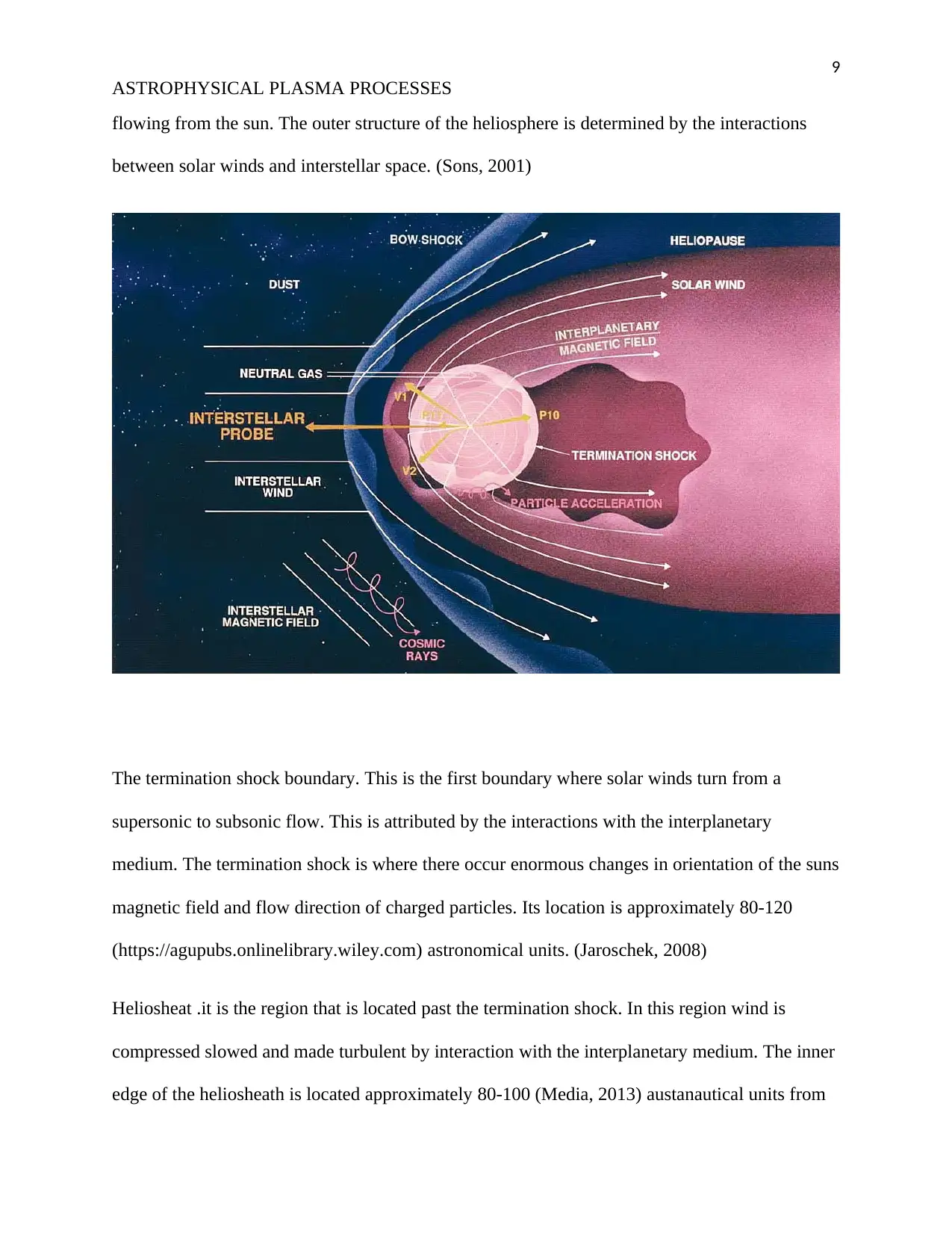
9
ASTROPHYSICAL PLASMA PROCESSES
flowing from the sun. The outer structure of the heliosphere is determined by the interactions
between solar winds and interstellar space. (Sons, 2001)
The termination shock boundary. This is the first boundary where solar winds turn from a
supersonic to subsonic flow. This is attributed by the interactions with the interplanetary
medium. The termination shock is where there occur enormous changes in orientation of the suns
magnetic field and flow direction of charged particles. Its location is approximately 80-120
(https://agupubs.onlinelibrary.wiley.com) astronomical units. (Jaroschek, 2008)
Heliosheat .it is the region that is located past the termination shock. In this region wind is
compressed slowed and made turbulent by interaction with the interplanetary medium. The inner
edge of the heliosheath is located approximately 80-100 (Media, 2013) austanautical units from
ASTROPHYSICAL PLASMA PROCESSES
flowing from the sun. The outer structure of the heliosphere is determined by the interactions
between solar winds and interstellar space. (Sons, 2001)
The termination shock boundary. This is the first boundary where solar winds turn from a
supersonic to subsonic flow. This is attributed by the interactions with the interplanetary
medium. The termination shock is where there occur enormous changes in orientation of the suns
magnetic field and flow direction of charged particles. Its location is approximately 80-120
(https://agupubs.onlinelibrary.wiley.com) astronomical units. (Jaroschek, 2008)
Heliosheat .it is the region that is located past the termination shock. In this region wind is
compressed slowed and made turbulent by interaction with the interplanetary medium. The inner
edge of the heliosheath is located approximately 80-100 (Media, 2013) austanautical units from
Paraphrase This Document
Need a fresh take? Get an instant paraphrase of this document with our AI Paraphraser
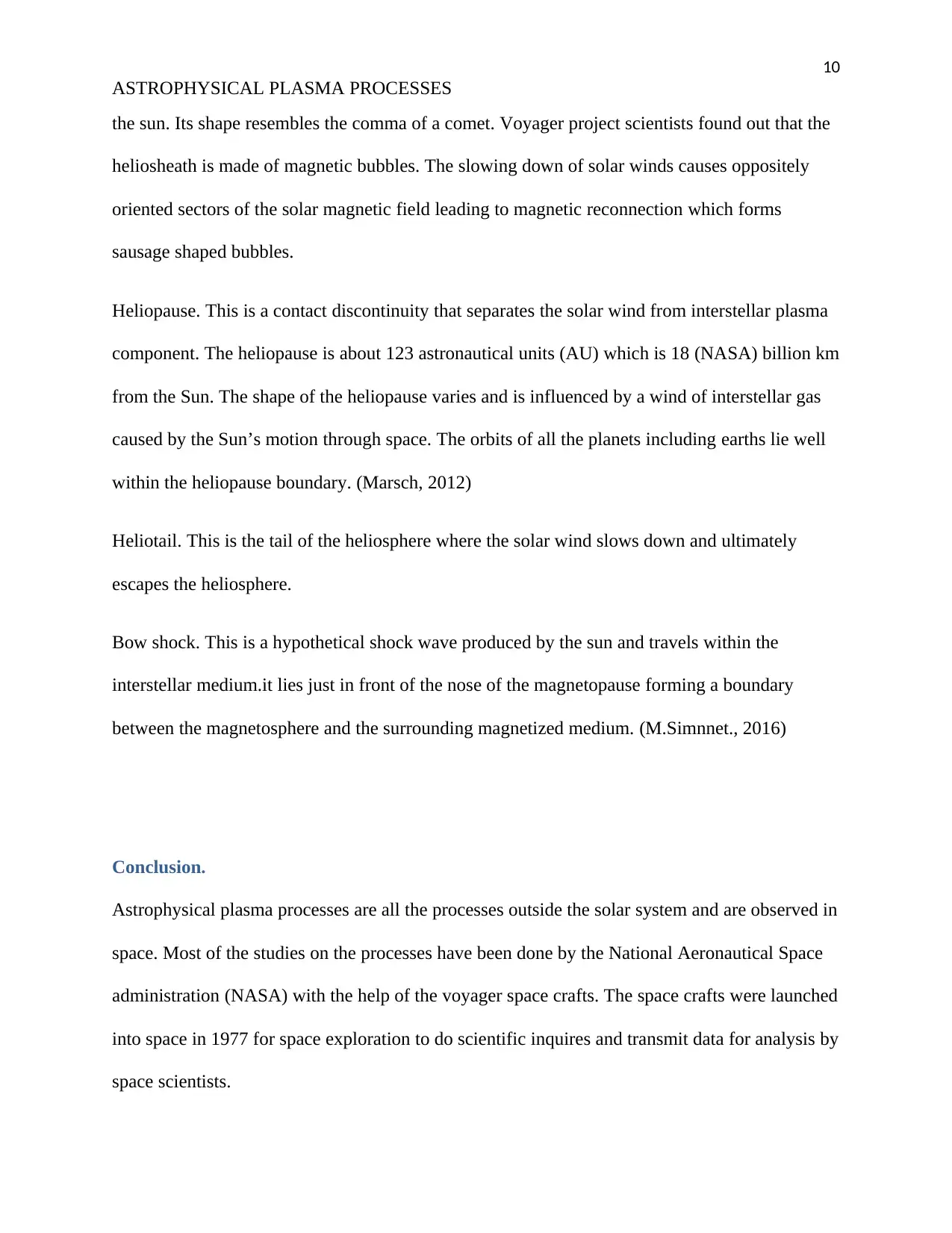
10
ASTROPHYSICAL PLASMA PROCESSES
the sun. Its shape resembles the comma of a comet. Voyager project scientists found out that the
heliosheath is made of magnetic bubbles. The slowing down of solar winds causes oppositely
oriented sectors of the solar magnetic field leading to magnetic reconnection which forms
sausage shaped bubbles.
Heliopause. This is a contact discontinuity that separates the solar wind from interstellar plasma
component. The heliopause is about 123 astronautical units (AU) which is 18 (NASA) billion km
from the Sun. The shape of the heliopause varies and is influenced by a wind of interstellar gas
caused by the Sun’s motion through space. The orbits of all the planets including earths lie well
within the heliopause boundary. (Marsch, 2012)
Heliotail. This is the tail of the heliosphere where the solar wind slows down and ultimately
escapes the heliosphere.
Bow shock. This is a hypothetical shock wave produced by the sun and travels within the
interstellar medium.it lies just in front of the nose of the magnetopause forming a boundary
between the magnetosphere and the surrounding magnetized medium. (M.Simnnet., 2016)
Conclusion.
Astrophysical plasma processes are all the processes outside the solar system and are observed in
space. Most of the studies on the processes have been done by the National Aeronautical Space
administration (NASA) with the help of the voyager space crafts. The space crafts were launched
into space in 1977 for space exploration to do scientific inquires and transmit data for analysis by
space scientists.
ASTROPHYSICAL PLASMA PROCESSES
the sun. Its shape resembles the comma of a comet. Voyager project scientists found out that the
heliosheath is made of magnetic bubbles. The slowing down of solar winds causes oppositely
oriented sectors of the solar magnetic field leading to magnetic reconnection which forms
sausage shaped bubbles.
Heliopause. This is a contact discontinuity that separates the solar wind from interstellar plasma
component. The heliopause is about 123 astronautical units (AU) which is 18 (NASA) billion km
from the Sun. The shape of the heliopause varies and is influenced by a wind of interstellar gas
caused by the Sun’s motion through space. The orbits of all the planets including earths lie well
within the heliopause boundary. (Marsch, 2012)
Heliotail. This is the tail of the heliosphere where the solar wind slows down and ultimately
escapes the heliosphere.
Bow shock. This is a hypothetical shock wave produced by the sun and travels within the
interstellar medium.it lies just in front of the nose of the magnetopause forming a boundary
between the magnetosphere and the surrounding magnetized medium. (M.Simnnet., 2016)
Conclusion.
Astrophysical plasma processes are all the processes outside the solar system and are observed in
space. Most of the studies on the processes have been done by the National Aeronautical Space
administration (NASA) with the help of the voyager space crafts. The space crafts were launched
into space in 1977 for space exploration to do scientific inquires and transmit data for analysis by
space scientists.
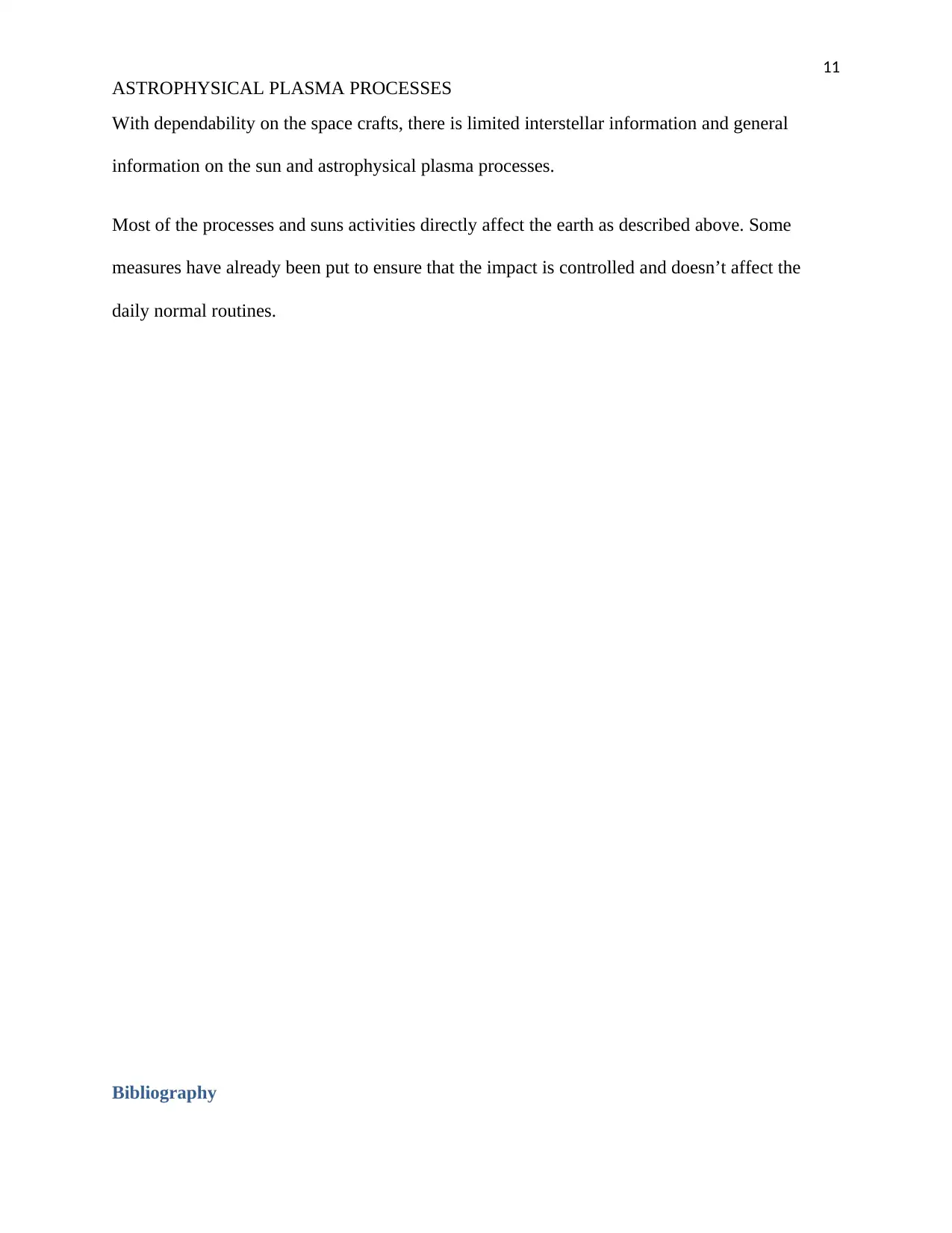
11
ASTROPHYSICAL PLASMA PROCESSES
With dependability on the space crafts, there is limited interstellar information and general
information on the sun and astrophysical plasma processes.
Most of the processes and suns activities directly affect the earth as described above. Some
measures have already been put to ensure that the impact is controlled and doesn’t affect the
daily normal routines.
Bibliography
ASTROPHYSICAL PLASMA PROCESSES
With dependability on the space crafts, there is limited interstellar information and general
information on the sun and astrophysical plasma processes.
Most of the processes and suns activities directly affect the earth as described above. Some
measures have already been put to ensure that the impact is controlled and doesn’t affect the
daily normal routines.
Bibliography
⊘ This is a preview!⊘
Do you want full access?
Subscribe today to unlock all pages.

Trusted by 1+ million students worldwide
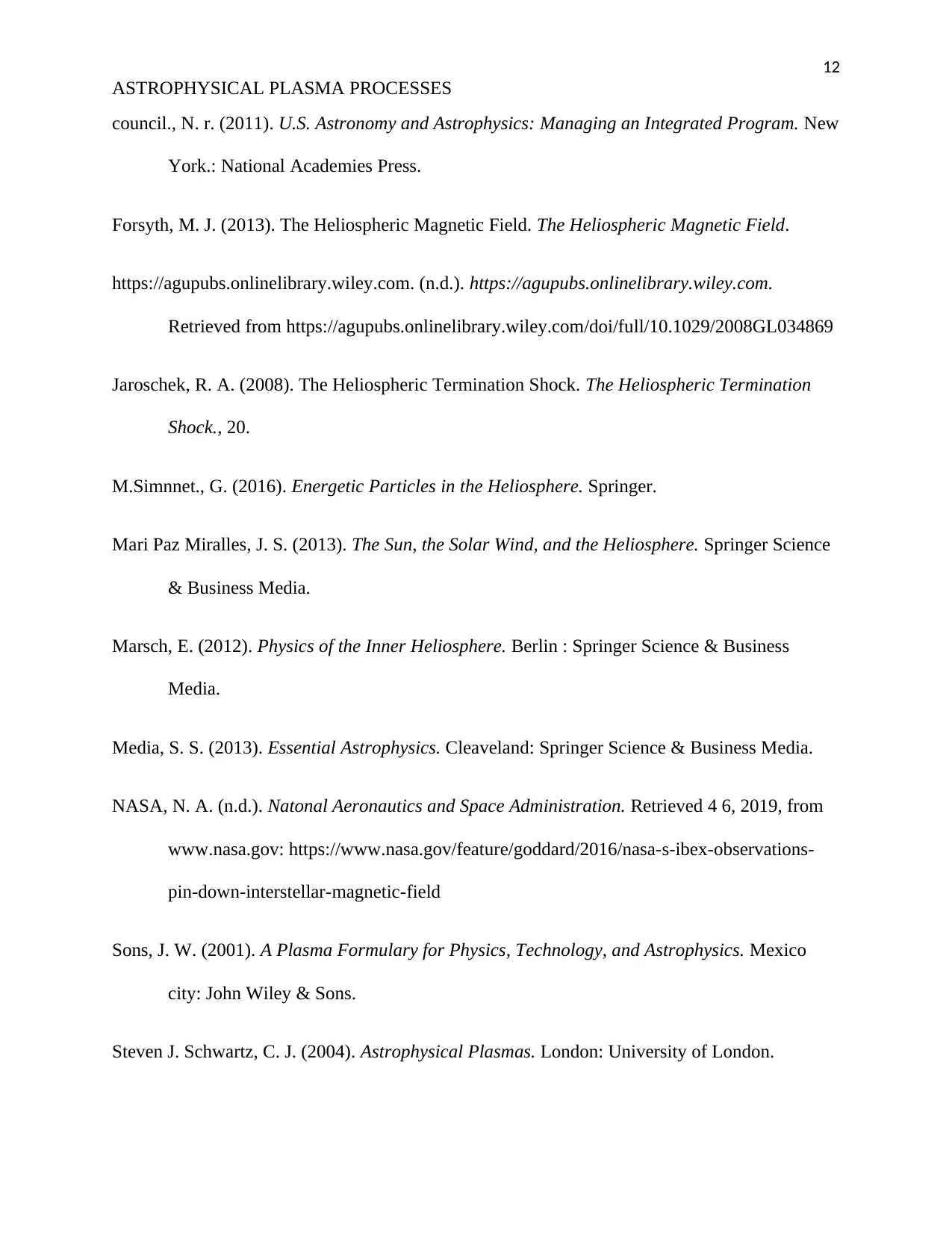
12
ASTROPHYSICAL PLASMA PROCESSES
council., N. r. (2011). U.S. Astronomy and Astrophysics: Managing an Integrated Program. New
York.: National Academies Press.
Forsyth, M. J. (2013). The Heliospheric Magnetic Field. The Heliospheric Magnetic Field.
https://agupubs.onlinelibrary.wiley.com. (n.d.). https://agupubs.onlinelibrary.wiley.com.
Retrieved from https://agupubs.onlinelibrary.wiley.com/doi/full/10.1029/2008GL034869
Jaroschek, R. A. (2008). The Heliospheric Termination Shock. The Heliospheric Termination
Shock., 20.
M.Simnnet., G. (2016). Energetic Particles in the Heliosphere. Springer.
Mari Paz Miralles, J. S. (2013). The Sun, the Solar Wind, and the Heliosphere. Springer Science
& Business Media.
Marsch, E. (2012). Physics of the Inner Heliosphere. Berlin : Springer Science & Business
Media.
Media, S. S. (2013). Essential Astrophysics. Cleaveland: Springer Science & Business Media.
NASA, N. A. (n.d.). Natonal Aeronautics and Space Administration. Retrieved 4 6, 2019, from
www.nasa.gov: https://www.nasa.gov/feature/goddard/2016/nasa-s-ibex-observations-
pin-down-interstellar-magnetic-field
Sons, J. W. (2001). A Plasma Formulary for Physics, Technology, and Astrophysics. Mexico
city: John Wiley & Sons.
Steven J. Schwartz, C. J. (2004). Astrophysical Plasmas. London: University of London.
ASTROPHYSICAL PLASMA PROCESSES
council., N. r. (2011). U.S. Astronomy and Astrophysics: Managing an Integrated Program. New
York.: National Academies Press.
Forsyth, M. J. (2013). The Heliospheric Magnetic Field. The Heliospheric Magnetic Field.
https://agupubs.onlinelibrary.wiley.com. (n.d.). https://agupubs.onlinelibrary.wiley.com.
Retrieved from https://agupubs.onlinelibrary.wiley.com/doi/full/10.1029/2008GL034869
Jaroschek, R. A. (2008). The Heliospheric Termination Shock. The Heliospheric Termination
Shock., 20.
M.Simnnet., G. (2016). Energetic Particles in the Heliosphere. Springer.
Mari Paz Miralles, J. S. (2013). The Sun, the Solar Wind, and the Heliosphere. Springer Science
& Business Media.
Marsch, E. (2012). Physics of the Inner Heliosphere. Berlin : Springer Science & Business
Media.
Media, S. S. (2013). Essential Astrophysics. Cleaveland: Springer Science & Business Media.
NASA, N. A. (n.d.). Natonal Aeronautics and Space Administration. Retrieved 4 6, 2019, from
www.nasa.gov: https://www.nasa.gov/feature/goddard/2016/nasa-s-ibex-observations-
pin-down-interstellar-magnetic-field
Sons, J. W. (2001). A Plasma Formulary for Physics, Technology, and Astrophysics. Mexico
city: John Wiley & Sons.
Steven J. Schwartz, C. J. (2004). Astrophysical Plasmas. London: University of London.
Paraphrase This Document
Need a fresh take? Get an instant paraphrase of this document with our AI Paraphraser

13
ASTROPHYSICAL PLASMA PROCESSES
ASTROPHYSICAL PLASMA PROCESSES
1 out of 14
Your All-in-One AI-Powered Toolkit for Academic Success.
+13062052269
info@desklib.com
Available 24*7 on WhatsApp / Email
![[object Object]](/_next/static/media/star-bottom.7253800d.svg)
Unlock your academic potential
© 2024 | Zucol Services PVT LTD | All rights reserved.